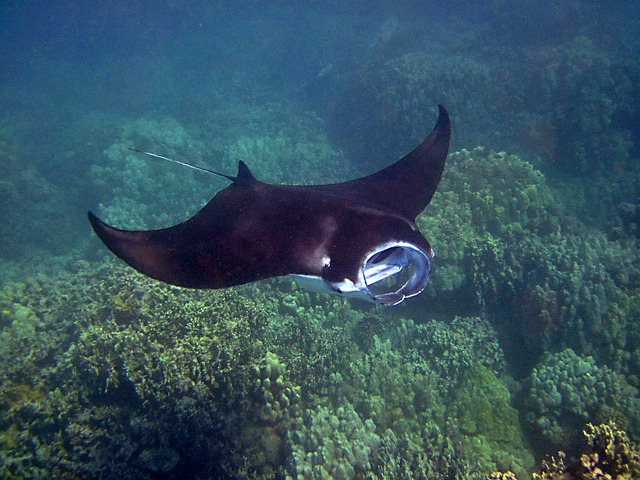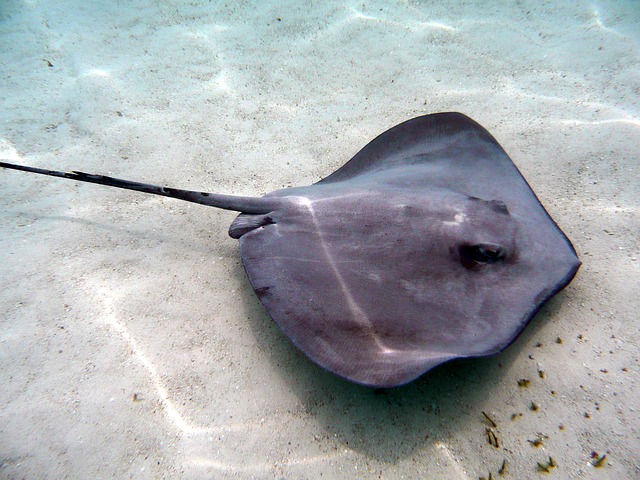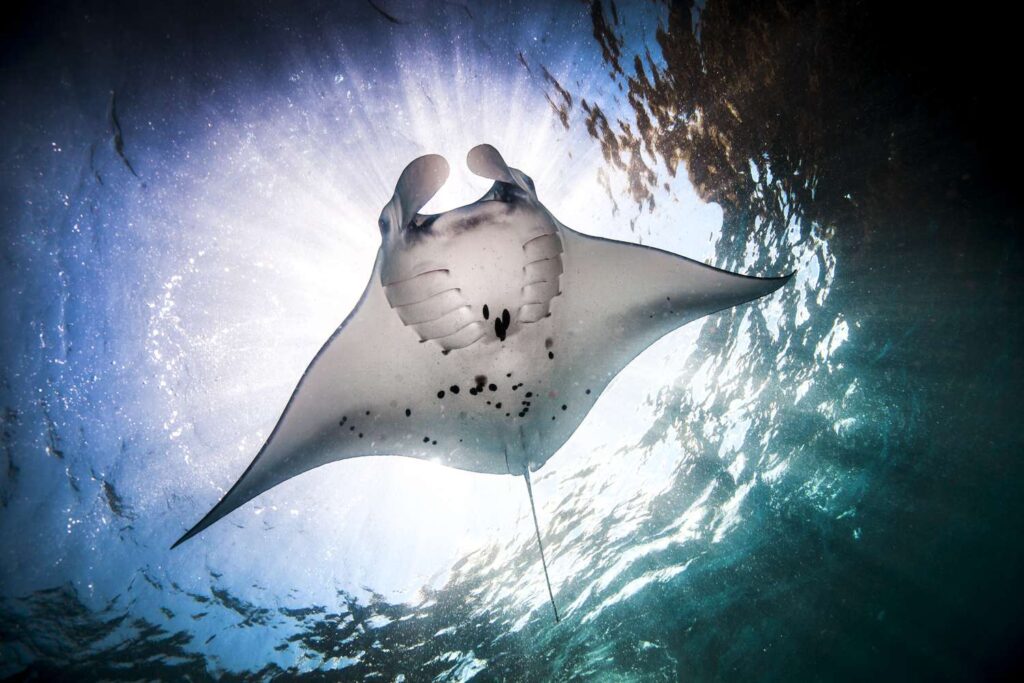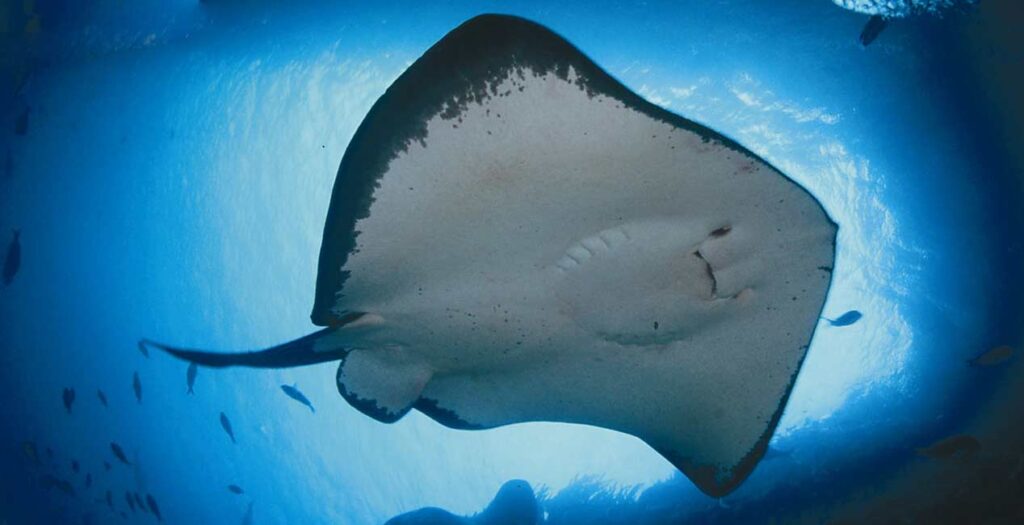Manta rays and stingrays belong to the same family of cartilaginous fishes, but they possess unique traits that set them apart. In this blog post, we will dive into the characteristics, size comparison, habitat differences, body shape, feeding behavior, coloration, anatomy, and conservation status of both manta rays and stingrays. By the end, you will have a comprehensive understanding of these captivating sea creatures and the factors that differentiate them.
Characteristics of Manta Rays
Manta rays are awe-inspiring creatures that inhabit the world’s oceans. These gentle giants are known for their enormous size and graceful movements. Here are some key characteristics that define manta rays:
Size: Manta rays are some of the largest fish in the ocean, with wing spans reaching up to 25 feet or more. They can weigh up to 3,000 pounds, making them true giants of the underwater world.
Body structure: Manta rays have a unique body shape that sets them apart. They have a flat, diamond-shaped body with long, slender wings known as pectoral fins. These fins are used for propulsion and elegant gliding through the water.
Coloration: Manta rays typically have a dark upper body, ranging from black to gray, which helps them blend with the deeper waters. Their undersides are lighter in color, often white or pale in appearance.
Mouth and gill slits: Manta rays have a large, cavernous mouth located on the front of their body. They use it to filter feed on plankton, their primary source of food. Additionally, they have five pairs of gill slits on the underside of their body, allowing them to extract oxygen from the water.
Characteristics of Stingrays
Stingrays, while sharing similarities with manta rays, possess distinct characteristics that differentiate them. Here are some notable features of stingrays:
Size: Stingrays come in various sizes, ranging from small species measuring only a few inches to larger species that can reach up to 6.5 feet in width. While still impressive, their size is relatively smaller compared to manta rays.
Body structure: Stingrays have a flat body shape, similar to manta rays. However, their pectoral fins are more triangular and less elongated, giving them a broader appearance. Unlike manta rays, some stingray species have a whip-like tail armed with one or more venomous spines for defense.
Coloration: Stingrays often display a camouflage pattern of mottled colors on their skin, which allows them to blend in with the ocean floor. This helps provide them with protection against predators and makes for efficient hunting.
Mouth and gill slits: Similar to manta rays, stingrays have a mouth on the underside of their body. Their feeding habits vary, with some species predominantly feeding on small fish and crustaceans, while others feed on mollusks and even plants. They possess several gill slits for respiration, located on the underside of their body.
Size Comparison between Manta Rays and Stingrays
Manta Ray: When it comes to size, manta rays outshine stingrays. As mentioned earlier, manta rays can attain staggering sizes with wingspans of up to 25 feet or more, while stingrays generally have a smaller size range.
Stingray: Stingray species can vary in size, with the smaller ones measuring just a few inches in width and the largest ones reaching up to 6.5 feet in width. This difference in size is one of the distinguishing factors between manta rays and stingrays.
Habitat Differences between Manta Rays and Stingrays
Manta rays and stingrays inhabit diverse aquatic habitats, but there are notable differences in their preferred environments.
Manta rays: They are commonly found in open ocean areas, usually near coral reefs and other productive marine ecosystems. They have a preference for warmer tropical and subtropical waters, such as the coastlines of Hawaii, Indonesia, Australia, and the Maldives. Manta rays are known to undertake long-distance migrations, following seasonal shifts in food availability and warmer waters.
Stingrays: On the other hand, stingrays tend to inhabit a wider range of habitats, including coastal waters, estuaries, and even freshwater rivers. Their ability to adapt to different environments allows them to thrive in various regions around the world.
Some species of stingrays prefer shallow, sandy areas close to the coast, while others inhabit deeper waters and even venture into oceanic depths.
Geographic Distribution of Manta Rays
Manta rays are found in both tropical and subtropical waters across the globe. They can be encountered in various regions, including but not limited to:
Indo-Pacific: Manta rays have a significant presence in the Indo-Pacific, with hotspots in countries such as Indonesia, the Maldives, Mozambique, the Philippines, and Thailand.
Western Atlantic: Manta rays can be spotted off the coastlines of Florida, the Bahamas, the Caribbean Islands, and parts of South America.
Eastern Pacific: They can be found in certain regions of Mexico, Costa Rica, Ecuador, and the Galapagos Islands.
These are just a few examples, but it’s important to note that manta rays have a widespread distribution throughout many warm oceanic regions.
Geographic Distribution of Stingrays
Stingrays possess a broader geographic distribution compared to manta rays. They can be found in various coastal and marine habitats across the world. Some notable regions include:
Caribbean Sea: Stingrays thrive in the warm waters of the Caribbean Sea, making their homes in areas such as the Cayman Islands, Turks and Caicos, and the Bahamas.
Indo-Pacific: This region is home to a wide variety of stingray species, ranging from the shallow waters of the Red Sea to the coral reefs of the Great Barrier Reef in Australia and the islands of Southeast Asia.
Gulf of Mexico: Stingrays can be found in the Gulf of Mexico, where they inhabit shallow coastal waters and estuaries, particularly along the coasts of Florida and Texas.
Amazon River Basin: In freshwater environments, stingrays have adapted to live in the Amazon River Basin, where they navigate the river’s murky depths.
These are just a few examples of some key regions where stingrays can be found. They have diverse distribution patterns across coastal and freshwater habitats around the world.
Physical Traits and Anatomy
Differences in Body Shape
One of the key differences between manta rays and stingrays lies in their body shapes.
Manta rays have a distinct diamond-shaped body with long, slender pectoral fins, often referred to as “wings.” These pectoral fins are broad and elongated, allowing manta rays to effortlessly glide through the water with graceful movements. The body of a manta ray is generally flat, with a wide head region and a tapering tail.
In contrast, stingrays have a more rounded body shape, resembling a disk or pancake. Their pectoral fins are triangular and less elongated compared to manta rays. While they are still capable of swimming with elegance, stingrays rely more on undulating movements of their entire bodies rather than the wing-like flapping motions of manta rays.
Anatomy of Manta Rays
The anatomy of manta rays is designed for their unique lifestyle as filter feeders. Some notable features include:
Gill Rakers: Manta rays have specialized structures called gill rakers, situated in the gill slits. These rakers filter out plankton and other tiny organisms from the water as it passes through, acting as a sieve to capture their food.
Large Mouth: Their mouth is located on the front underside of their body and is used to engulf large volumes of water containing their microscopic prey. They do not have teeth, as their diet primarily consists of small organisms such as zooplankton.
Spiracles: Manta rays have a pair of spiracles, which are located on top of their heads behind their eyes. These structures help transport water to the gills, allowing manta rays to breathe more efficiently when stationary or when buried in sediment.
Skin: The skin of manta rays is smooth and covered in dermal denticles, which are small, tooth-like scales. These denticles reduce drag and contribute to their streamlined swimming ability.
Anatomy of Stingrays
Stingrays possess anatomical features that suit their predatory lifestyle and aid in defense. Key anatomical characteristics of stingrays include:
Venomous Spines: Most stingray species have one or more venomous spines on their tails. These spines contain venom that can cause painful injuries or even be potentially fatal to predators or humans if stung. It acts as a deterrent and defense mechanism against threats.
Mouth and Dental Plates: Stingrays have a large, flat mouth located on their ventral side. In contrast to manta rays, some species of stingrays possess strong teeth or dental plates that are used to crush the shells of their prey, such as bivalves and crustaceans.
Ampullae of Lorenzini: These sensory organs are located around the head of stingrays. They detect weak electric fields emitted by potential prey, helping stingrays locate hidden or buried organisms in the sand or sediments.
Ventral Gills: Similar to manta rays, stingrays possess ventral gills that allow them to extract oxygen from the water. These gills are covered by a protective plate known as the branchial chamber, which also helps create water flow for respiration.
Differences in Coloration and Patterns
Manta rays and stingrays are two unique species whose differences extend to their coloration and patterns.
Manta Rays: They typically exhibit a simple, bicolored pattern. Their dorsal (upper) side is dark, usually black or dark blue, allowing them to blend in with the vast ocean abyss when viewed from above. On the other hand, their ventral (underneath) side is lighter, often white or pale, providing them camouflage against the sky when seen from below.
Though some species have unique mark patterns on their ventral side, there is generally minimal change in their overall coloration.
Stingrays: On the other hand, stingrays demonstrate more varied coloration and patterns. The color of their dorsal side may range from gray to olive, brown, yellow, or even pink, and their bellies are typically white or pale. They often have more complex color patterns or markings, including spots or stripes that assist in camouflage against their living environment, usually sandy, muddy, or rocky seabeds.
However, the given coloration usually varies greatly depending on the species and environment in which they live.
Classification and Types
Types of Manta Rays
There are two recognized species of manta rays that display slight differences in their appearance, behavior, and habitats.
Giant Manta Ray – Mobula birostris: This is considered the larger species between the two. They can reach a wingspan of up to 29 feet, and their coloration varies from black, dark brown to a stunning blue or purples. They are typically found in oceanic waters and often featured in diving spots due to their majestic presence.
Reef Manta Ray – Mobula alfredi: These species are typically smaller than their giant counterparts, reaching a maximum wingspan of 18 feet. Their color schemes can also range from black, brown, to blue, but they are identified by the distinct spots on their bellies. As their name suggests, they inhabit close to coastal areas and coral reefs.
Types of Stingrays
With over 200 known species in the Stingray family, it’s impossible to describe them all. However, here are a few of the most recognized ones:
Southern Stingray – Hypanus americanus: Known for their diamond-shaped bodies, Southern stingrays are widely found in Atlantic waters. They have gray or brown dorsal sides that help them to blend flawlessly into the sandy bottoms.
Blue-spotted Stingray – Neotrygon kuhlii: This is an easily recognizable species due to their bright blue spots on their olive or brown backs. They inhabit the sand flats and reefs of the tropical Indo-West Pacific region.
Round Stingray – Urobatis halleri: This species gets its name from its round body shape, unlike the common diamond shape of most stingrays. They are generally brown but can also be gray or olive, and they are mostly found in shallow coastal waters of the Eastern Pacific.
Giant Freshwater Stingray – Himantura polylepis: Reaching a remarkable size of up to 16.5 feet in length and 5 feet in width, this giant species is an awe-inspiring presence in river habitats across Southeast Asia. The coloration varies from grey to brown and they can cope with both freshwater and brackish water conditions.
Conservation Status
Conservation Status for Manta Rays
Manta rays are currently facing significant threats and they are sadly in decline. According to the IUCN, both the Giant Manta Ray (Mobula birostris) and the Reef Manta Ray (Mobula alfredi) are listed as “Vulnerable” on the IUCN Red List of Threatened Species.
They are primarily threatened by human activities, including targeted fishing for their gill plates, which are in high demand in some markets for their supposed medicinal value. Accidental capture in fishing nets, marine pollution, and habitat degradation are other significant factors leading to this decline.
Conservation Status for Stingrays
The conservation status of stingrays varies greatly from species to species, mainly due to their diverse range and habitats. However, numerous stingray species share a similar fate to manta rays. According to the IUCN, many stingray species are listed as “Data Deficient” due to the lack of available data on their populations, while others are listed as “Near Threatened” or “Vulnerable”.
They are primarily subjected to threats like overfishing, habitat degradation, pollution, climate change, and accidental by-catch in fishing gear. Their life history traits, such as late maturity and producing few offspring, make them especially vulnerable to these pressures.
Summary of Key Difference between Manta Rays and Stingrays:
Understanding the distinctive characteristics, size comparisons, habitat differences, body shapes, feeding and swimming behaviors, coloration, and conservation status of manta rays and stingrays highlights the remarkable diversity present in our oceans. Although they share certain traits, these creatures have evolved specific adaptations that enable them to thrive in their respective environments. Protecting and conserving these magnificent creatures is crucial for maintaining the delicate balance of marine ecosystems.





